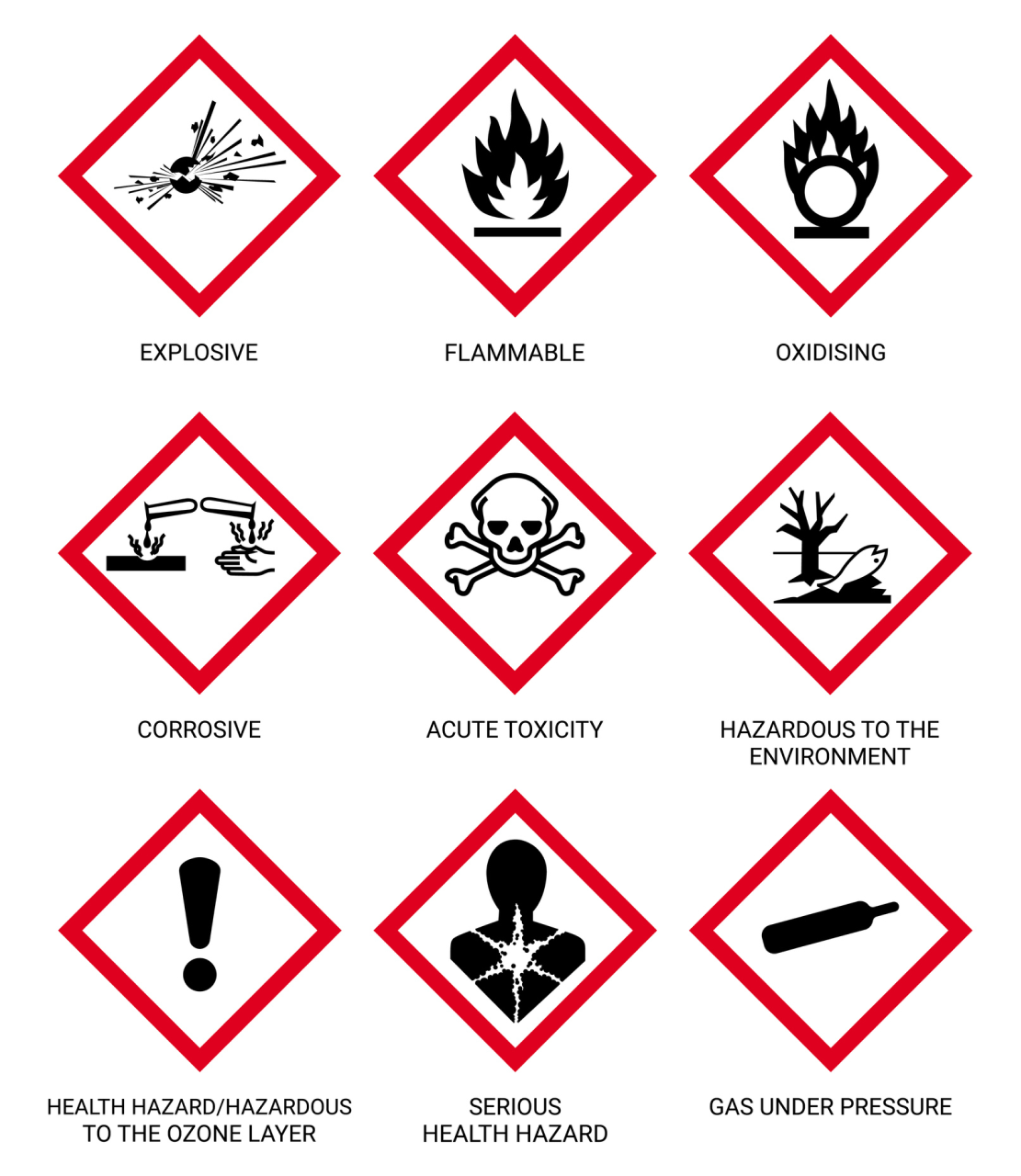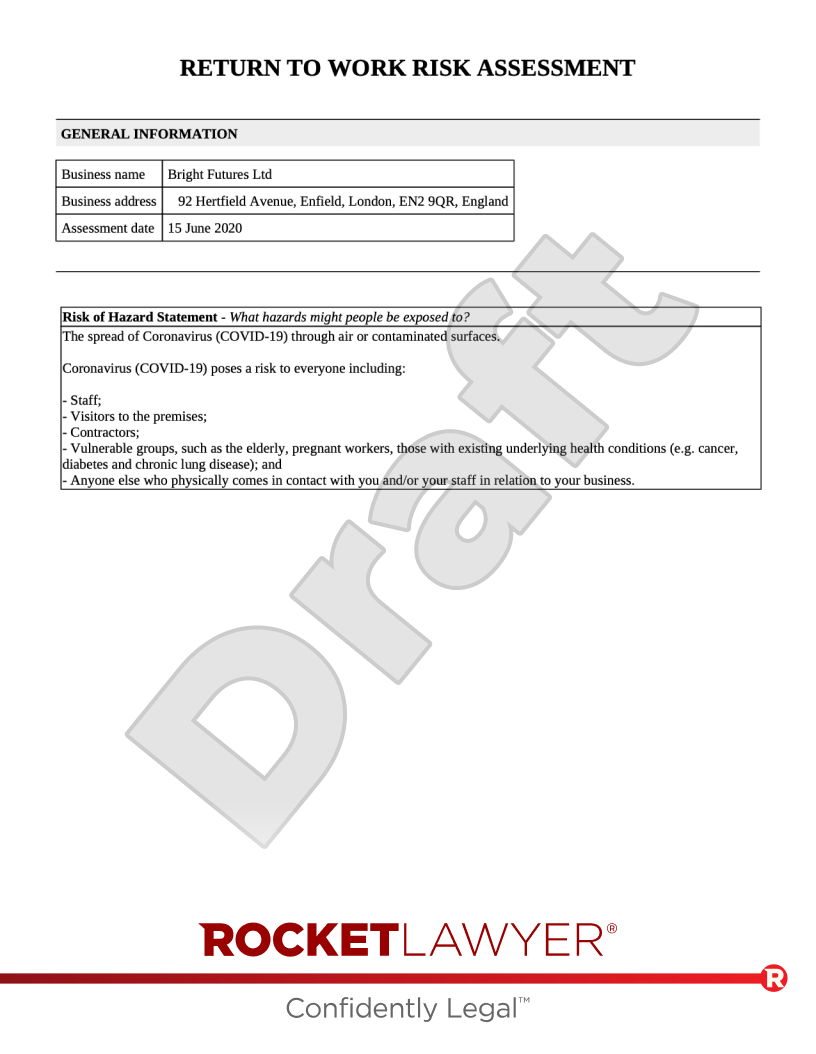What is COSHH?
The Control of Substances Hazardous to Health Regulations 2002 (COSHH) were brought in to protect workers from ill health in the workplace. They are one of the most important health and safety regulations for any business using harmful chemicals or substances. They set out requirements that businesses and employers must follow to minimise the risk of harm to workers.
Who does COSHH apply to?
COSHH applies to all employers. If you are self-employed, all parts of COSHH other than monitoring and surveillance requirements (explained below) still apply.
Hazardous substances under COSHH
Hazardous substances are solids, liquids or gases that have a detrimental effect on a person’s health. Detrimental effects can range from skin conditions (eg dermatitis) to serious chronic diseases (eg cancer or asthma).
Remember to think beyond just toxic substances when considering what a harmful substance is. Substances such as dust can be hazardous too, though not as harmful as other (eg poisonous) substances.
Which hazardous substances are covered by COSHH?
COSHH covers various types of substances, including:
-
chemicals (including products containing chemicals)
-
fumes, vapours, and mists
-
dust (eg wood dust from sanding or silica dust from tile cutting)
-
nanotechnology (ie extremely small, atomic-sized tools, and machinery)
-
gases and asphyxiating gases
-
biological agents (eg micro-organisms or cell cultures)
-
germs that can cause disease (eg leptospirosis or legionnaires disease) and germs used in laboratories
Which hazardous substances are not covered?
COSHH does not cover:
These each have their own separate guidelines and requirements. For more information, read Health and Safety Executive (HSE) guidance.
How to carry out a COSHH risk assessment
Employers have a general duty to perform risk assessments under the Health and Safety at Work etc Act 1979. COSHH requires further steps to be taken for employers dealing with harmful substances. An employer must not carry out any work involving hazardous substances until a satisfactory, COSHH compliant risk assessment has been completed.
Certain requirements apply to how an employer must manage COSHH risk assessments. They must:
-
be carried out by a competent person (ie someone who has the required skills, experience, and knowledge to complete the job correctly)
-
be recorded in writing if the employer has 5 or more employees. If an employer has fewer than 5 employees, recording a risk assessment can still be pragmatic, as it can help with any future negligence claims or with reviewing safety practices
-
be regularly reviewed. Employers must regularly:
-
review risk assessments to ensure they have an up-to-date account of all the hazards and risks within the workplace
-
test that the previously implemented controls are working
-
change any failing controls
-
immediately update controls if there has been a change in the workplace which could cause exposures to harmful substances. Changes to watch out for include changes to staff, processes, or equipment, or the introduction of new substances
-
Conducting a COSHH compliant risk assessment requires an employer to:
Identify the hazards
Identify which substances are harmful by reading the product labels. Examples of the product label indicators for some types of hazardous substance can be seen below:

Chemical safety data sheets can be found on packaging for chemical products. These are helpful for identifying which substances are harmful, but they are not a risk assessment and should not be used as one. They will describe the chemicals present and will provide information on product handling, storage, and emergency measures. Suppliers of chemicals must provide a current safety data sheet with a substance if it is dangerous.
Workplace exposure limits will also be a good indicator of which substances are hazardous (details below).
Employers should also identify how harmful substances might be produced by work processes. Examples include substances produced by:
-
machinery or tools that emit dust, fumes, or gas when being operated (eg cutting or grinding)
-
equipment that releases fumes, vapour, mist, or gas when in use (eg welding or extruders that shape plastic)
-
skin contact with liquids, pastes, or dusts (eg wet work)
Assess the hazards
Employers should consider who might be harmed, how, and to what extent. This could include considering:
-
the method of exposure (eg breathing a substance in or accidentally touching a substance)
-
the effects of exposure
-
the period of time workers are exposed for and how frequently
-
who else might be exposed
-
what control measures will be needed to limit the risk of exposure
-
who needs to carry out the control measures
-
when is action needed by
For more information on carrying out workplace risk assessments, read Risk assessments at work.
What are workplace exposure limits?
Workplace exposure limits (WELs) are HSE-approved, legally binding rules set in place for work premises to minimise exposure to certain substances. WELs show the limits relating to the concentrations of certain hazardous substances in the air.
Only about 500 substances have WELs. The list of WELs can be found in the HSE guidance. Employers must monitor the exposure levels of substances subject to WELs.
COSHH control measures
Once a COSHH risk assessment has been carried out, an employer must use their assessment to decide on actions to take to control the health and safety risks posed by the hazards they’ve identified.
Control measures should be tailored to a workplace’s specific needs. The types of measures used generally fit into the following categories:
1. Elimination or substitution
Taking away a hazardous substance is the most effective way of protecting staff. Employers should consider whether they really need to use a hazardous substance, whether it could be replaced with another less harmful substance, or whether they could change processes so it isn’t produced.
For example, could a powder be replaced with a liquid to avoid producing harmful dust?
2. Containment
Employers can enclose the storage of hazardous substances and activities that use (or produce) them to minimise unprotected persons’ exposure to them. Persons not relevant to the storage or activity should be restricted from accessing the area.
Secure local exhaust ventilation systems (LEVs) can extract gases, mist, dust, and fumes from within an enclosed area to decrease the risk of exposure. Any ventilation equipment used must be examined every 14 months by a qualified person (ie someone with the required experience, skills and knowledge).
Employers should also consider whether they need to incorporate decontamination equipment and procedures into the workplace to stop hazardous substances being transferred out of the enclosed area.
Ensuring that hazardous substances are sealed in appropriate containers when they are transferred or disposed of is important for limiting how the materials are handled or exposed.
3. Protective equipment
Personal protective equipment (PPE) should only be considered by employers if other control measures are inadequate and should always be used in combination with another control measure.
Employers are responsible for providing, replacing, and paying for PPE. Types of workplace PPE include:
-
protective gloves, clothing, and footwear
-
respirators (ie air filtering devices) or breathing apparatus (ie air supplying devices)
-
eye protection
Employers should engage with PPE suppliers, manufacturers, and trade associations to determine what protective equipment suits their needs.
4. Cleaning
Hazardous substances are often used when cleaning a workplace (eg bleach). Employers should make certain that the workplace can be cleaned easily and efficiently, to avoid anyone cleaning being exposed to harmful substances for longer than necessary. This can be achieved by:
-
having smooth work surfaces that are easy to clean
-
using protective equipment (eg gloves or goggles)
-
providing recovery stations for eyes and hands which include washing apparatus (eg sinks or hoses), skin creams, and sanitisers
5. Ways of working
Control measures can include operational procedures, supervision, and worker training. Staff who work with hazardous substances must be provided training and instruction. This is inclusive of contractors, cleaning, and maintenance staff. Staff must understand:
-
what the hazards and risks are
-
if there are any WELs
-
the results of monitoring and surveillance
-
the effects of exposure
-
the operational procedures for using any hazardous substances. They must have access to chemical safety data sheets
-
how to test the control measures
-
emergency procedures
It would be helpful for employers to keep a physical or digital health and safety handbook containing policies and training guides for staff to access.
Employers should keep basic training records and records of equipment inspections, tests, and repairs for at least 5 years. This will help to identify any patterns in equipment deterioration.
It is important that employers encourage and require their staff to properly follow hazardous substances training, protect themselves, and warn supervisors if anything appears wrong.
6. High-risk systems of work
A permit-to-work system is a previously agreed, documented safety procedure which must be followed where proposed work is considered high-risk. It authorises specific staff to carry out the work within a specific time frame. The procedure document will detail the safety precautions, time frame, and step-by-step process based on a risk assessment completed for the work.
A permit-to-work requires declarations to be made by the people authorising and carrying out the work. This will include those involved in shift handover procedures and will be required for any extensions to the work.
7. Accidents
Employers should have a plan for when foreseeable accidents and emergencies happen. They should ensure that:
-
the right equipment is accessible for handling the accident
-
the right procedures are in place and known to workers
-
the right people are trained to take action
COSHH monitoring
Employers should continuously monitor COSHH control measures to ensure that their control measures are working. Monitoring can also be a good indicator of how contamination is spreading if the control measures have failed (eg a hazardous gas might be spreading through the premises due to the ventilation system failing). Monitoring methods include:
-
screening (eg meters and colorimetric detector tubes) will provide information on the concentration levels of substances in the air which workers are exposed to
-
personal air monitoring will help track how much of a substance a worker inhales
-
biological monitoring will measure the amount of substance within a worker’s body
Monitoring can involve health surveillance. This is any monitoring that involves obtaining staff members’ health information to protect them from risks at work (eg biological monitoring). It is often necessary when:
-
workers are using a substances associated with a disease
-
it is possible to detect the negative effects of the substance to reduce the risk of further harm
-
workplace conditions make it likely that the disease could materialise
Depending on the assessment being performed, employers must consider who should perform the assessment: a doctor, a nurse or a responsible person?
Employers must:
-
take action in response to concerning results they receive from any monitoring they perform (eg changing work processes in relation to a harmful substance, moving the relevant worker, or finding an alternative)
-
make workers aware of the results of both workplace monitoring and health surveillance
For more information on managing information obtained via health surveillance, read Managing staff health data.




